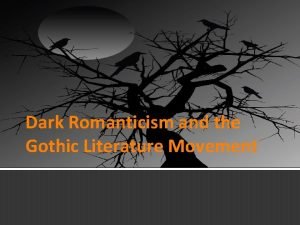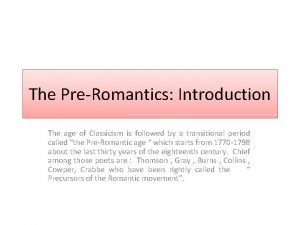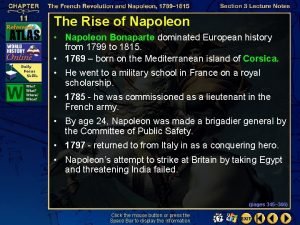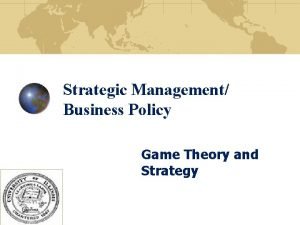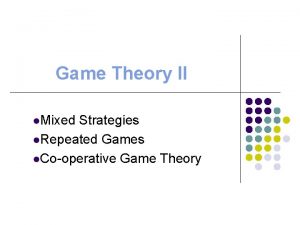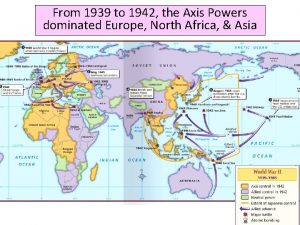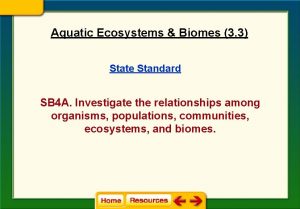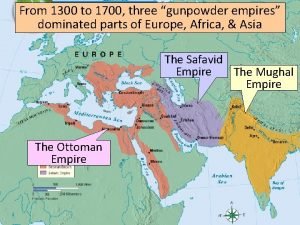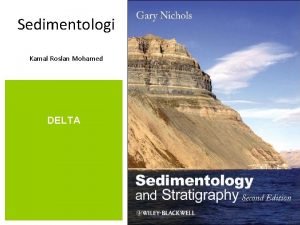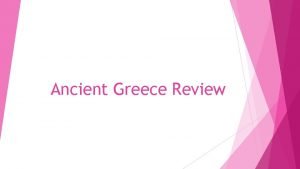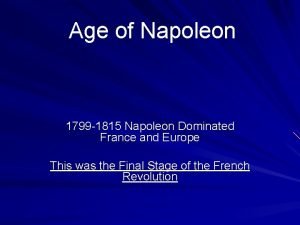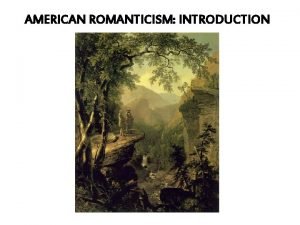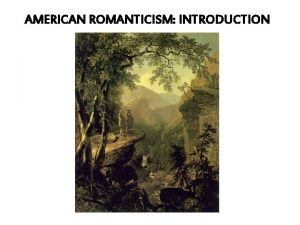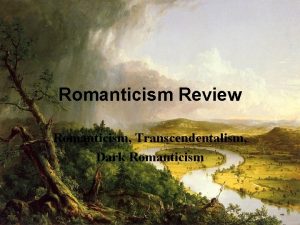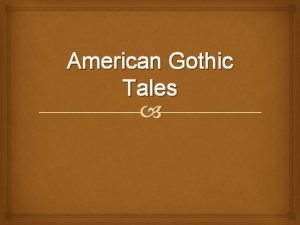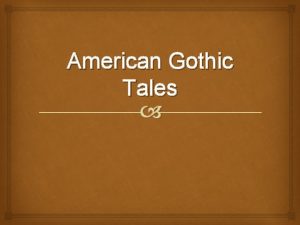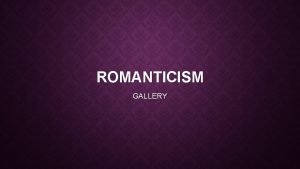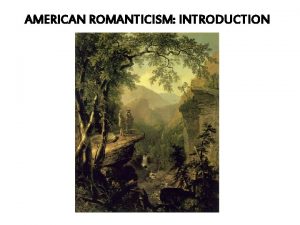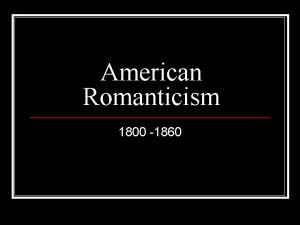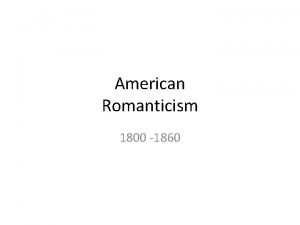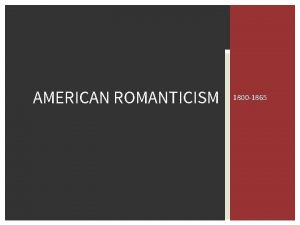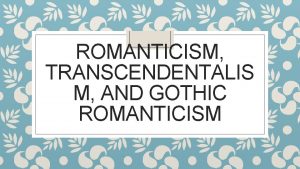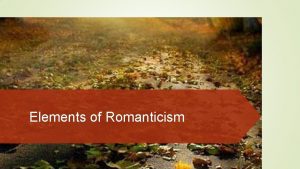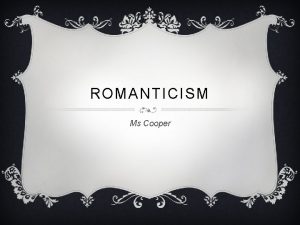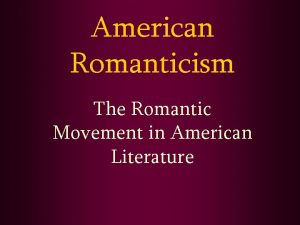AMERICAN ROMANTICISM INTRODUCTION ROMANTICISM THE MOVEMENT dominated cultural

















- Slides: 17

AMERICAN ROMANTICISM: INTRODUCTION

ROMANTICISM: THE MOVEMENT - dominated cultural thought from the last decade of the 18 th century well into the first decades of the 20 th century - First appearance in Germany in the 1770 s (“Sturm und Drang”); flowering in England in the 1790 s; importation to America from the 1820 s onward • To a large degree, Romanticism was a reaction against the Enlightenment or Age of Reason, especially its emphasis on formal propriety*, classical style, and decorum *decency; courtesy

ROMANTICISM: THE MOVEMENT • Question: What comes to mind or what do you associate with the term “Romanticism”?

ROMANTICISM: THE MOVEMENT • Although we usually associate a quaint or exaggerated effusion of emotion with Romanticism (hence, the shift in meaning of the word “Romantic” to everything relating love…), the Romantic age brought about concepts of the individual and his/her relationship to the world/society that we still largely subscribe to, even champion today.

• • ROMANTICISM: Idealism We can make the world a better place. Man) (Common Romantics believed in the natural goodness of humans which is hindered by the urban life of civilization. • Concern for the common man: came from both the democratic changes of the age of Revolution, as well as an interest in folk culture • Believed savage is noble, childhood is good and emotions inspired by both beliefs causes the heart to soar • In part, the search to preserve the stories, songs, legends, and verse of the common people came from a nationalistic impulse – E. g. in Germany, the Grimm brothers collected the fairy tales (“Rapunzel”, “Hansel and Gretel” and “Cinderella”, to name a few) of their region and country while assembling a comprehensive dictionary of the German language (the German equivalent of Webster’s in the 19 th century!) • But: the Folk Movement also produced an international language of human commonality, at whose center stood the images of home and the heart.

ROMANTICISM: Intuition • Romantics placed value on “intuition, ” or feeling and instincts, over reason – STRONG SENSES, EMOTIONS AND FEELINGS!! • The artist (especially, the poet): takes on quasi-religious status not only as prophet and moral leader • Inspired creator vs. technical master; being spontaneous vs. getting it precise • The poet/artist as a divinely inspired vehicle through which Nature and the common man find their voices • Wordsworth said it best: “all good poetry is the spontaneous overflow of powerful feelings. ”

ROMANTICISM: Individuality • aesthetic changes: individuality translated into the revolution of feeling against form • Poets, painters, and musicians no longer trying to make their expression fit conventional forms, but carving out new forms to capture their feelings and thoughts • Women’s Rights and Abolitionism were taking root as major movements of this time period • Romantics elevated the achievements of the misunderstood, heroic individual outcast • Walt Whitman, a later Romantic writer, would later write a poem entitled “Song of Myself: ” it begins, “I celebrate myself…”

ROMANTICISM: Nature • For the Romantic, nature was a constant companion and teacher--both benign and tyrannical • Nature became – the stage on which the human drama was played – the context in which man came to understand his place in the universe – the transforming agent which harmonized the individual soul with what the Transcendentalists would call the Over-Soul (to be discussed later).

ROMANTICISM: More Nature • Throughout all of Romantic literature, music, and art, Nature is a dynamic presence, a character who speaks in a language of symbols at once mysterious and anthropomorphic (i. e. speaking with a voice similar to human voice, i. e. sharing human qualities and characteristics, especially in personification of natural objects, phenomena, etc. ) • allows man to come into dialogue with the lifeforce

ROMANTICISM: Imagination • Imagination was emphasized over “reason. ” • Imagination was considered necessary for creating all art. British writer Samuel Taylor Coleridge called it “intellectual intuition. ” • Romantics legitimized the individual imagination as a critical authority.

ROMANTICISM: THE Characters • Quintessential Romantic figures: the hero, the wanderer, and the genius: – all journey to new lands (literally and figuratively), defy limitations, and overcome obstacles – SHREK, anybody? ? ? – Hero/wanderer fascination also came from the Romantic identification and exploration of everything Medieval (the Middle Ages were thought to be characterized by mystery and irrationality) • Typical Romantic motifs: – Exotic lands (Melville, especially his South Sea novels and Moby Dick) – Amorphous world of dreams (Coleridge, “Kubla Khan”) – written after experiencing opium-influenced dream; never finished – Dark terrors of the psyche (E. A. Poe!) – Dizzying heights—in both nature and human creativity (Frankenstein…) – Sublime vistas in nature reflecting the divine and potentially terrifying powers of the human mind, spirit, and soul

ROMANTICISM: MAJOR FIGURES • Germany: – Authors: Goethe (esp. The Sorrows of Young Werther and Faust), Schiller (esp. William Tell); Novalis, Eichendorff, Schlegel, and the Grimm brothers – Painters: Caspar David Friedrich – Composers: Beethoven, Schubert (songs), Mendelssohn (wedding march from Midsummer Night’s Dream), Richard Wagner

ROMANTICISM: MAJOR FIGURES • Great Britain: – Authors: Robert Burns, William Blake, William Wordsworth, Sir Walter Scott, Samuel Taylor Coleridge, Percy Bysshe Shelley, Mary Shelley. – Painters: William Blake, John Constable, Joseph Turner

AMERICAN ROMANTICISM • Often associated with the terms “American Renaissance” and “Transcendentalism” • Poets: William Cullen Bryant, Henry Wadsworth Longfellow, John Greenleaf Whittier, Walt Whitman, Emily Dickinson • Prose Writers: Washington Irving, James Fenimore Cooper, Nathaniel Hawthorne, Edgar Allan Poe, Ralph Waldo Emerson, Henry David Thoreau, Harriet Beecher Stowe, Herman Melville.

Statements that Embody or Suggest Romanticism 1. The answers to life’s most puzzling questions can be found through discussions with a simple person who lives in the country close to naturenot with a sophisticated, well-educated person from the city. 2. The answer to life’s most puzzling questions can be found through a connection with nature. 3. The use of one’s imagination is more important than rational thought. 4. Subjectivity is more important than objectivity. 5. Knowledge is gained through gut reactions and subject hunches rather than level-headed, objective, deductive thought.

Statements that Embody or Suggest Romanticism 6. Nature is more important than art. 7. Experimental trial and error is a better process than the conventional scientific method. 8. Poetry should be spontaneous and full of emotion, not planned an straightforward. 9. Sensitivity, feelings, and spontaneity are more important than intellectualism. 10. “Dare to be” is a better battle-cry than “dare to know. ”

Works Cited • Information from: Read. Write. Think, Copyright 2008.
 Gothic vs. dark romanticism
Gothic vs. dark romanticism Pre romantic period
Pre romantic period The romanticism (1795 — 1835) what is romanticism
The romanticism (1795 — 1835) what is romanticism Napoleon bonaparte dominated
Napoleon bonaparte dominated Game theory strategic management
Game theory strategic management What is teacher dominated approach
What is teacher dominated approach Shapley value game theory
Shapley value game theory Who dominated europe, north africa and asia from 1939-1942?
Who dominated europe, north africa and asia from 1939-1942? Wetland dominated by nonwoody plants
Wetland dominated by nonwoody plants “gunpowder empires” dominated
“gunpowder empires” dominated Marine ecosystem dominated by marsh grasses
Marine ecosystem dominated by marsh grasses River dominated delta
River dominated delta A market dominated by a single seller
A market dominated by a single seller Divestment in consumer decision process
Divestment in consumer decision process Barriers to entry for perfect competition
Barriers to entry for perfect competition Greek civilization began in an area dominated by
Greek civilization began in an area dominated by Napoleon bonaparte dominated
Napoleon bonaparte dominated Revenue dominated cash flow
Revenue dominated cash flow
